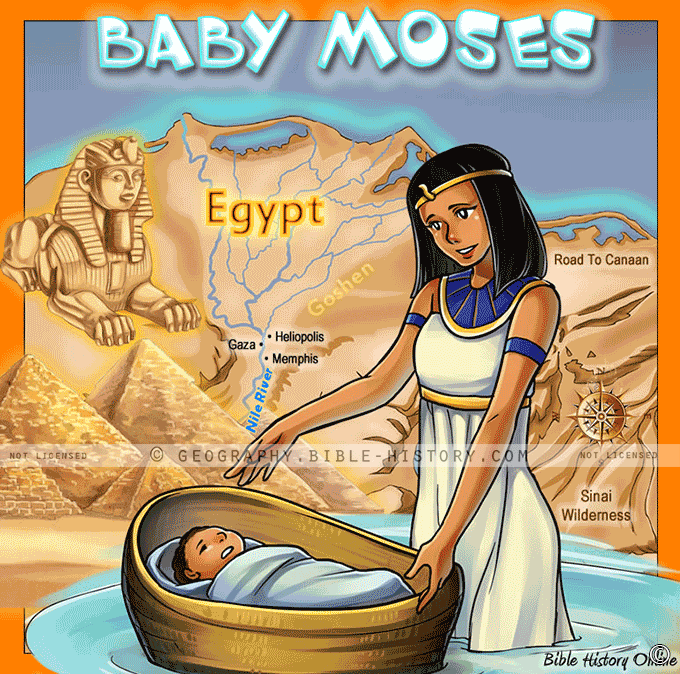
The story of Baby Moses is a timeless tale of courage, faith, and divine intervention that has captivated hearts for generations. This narrative, found in the book of Exodus, unfolds within a backdrop of oppression, resilience, and the unwavering belief in God's providence. As we delve into the tale of Baby Moses, we uncover a story of hope and deliverance that continues to inspire people of all ages.
The story of Baby Moses begins during a time of great adversity for the Israelites. Enslaved and oppressed in Egypt, the Israelites faced the threat of infanticide as Pharaoh decreed the killing of all Hebrew baby boys. In the midst of this darkness, Moses's mother placed him in a carefully crafted basket and set it afloat on the Nile River, entrusting her son's fate to the currents of the river and the hands of a higher power.
God's providence is woven throughout the story of Baby Moses. As fate would have it, the basket carrying the infant Moses was discovered by Pharaoh's daughter, who was moved by compassion. Moses's sister, Miriam, seized the opportunity and offered to find a Hebrew nursemaid for the child – a role that was fulfilled by Moses's own mother. This arrangement not only preserved Moses's life but also ensured that he would grow up with a strong connection to his Hebrew heritage.
As Baby Moses grew, he became an instrument of God's plan to deliver the Israelites from bondage. Raised within the royal palace, he received an education and a unique perspective that would later prove invaluable. The story of Baby Moses is not just about the miraculous preservation of his life; it's about the shaping of a leader who would lead his people to freedom.
The story of Baby Moses offers numerous lessons for contemporary times. It teaches us about the power of a mother's love, the courage to defy injustice, and the divine protection that can guide us even in the face of seemingly insurmountable odds. It also reminds us that even in moments of despair, God's plan is at work, orchestrating events to bring about redemption and deliverance.
The story of Baby Moses is ultimately a story of hope. It shows that even in the darkest times, when the odds are stacked against us, there is a divine presence that watches over and guides our paths. It reminds us that from the most vulnerable beginnings can emerge leaders who inspire change, and from the depths of despair can arise stories of triumph and liberation.
The story of Baby Moses resonates across generations, touching hearts with its themes of faith, resilience, and the unbreakable bond between a mother and her child. It serves as a beacon of hope, reminding us that even amidst adversity, there is a higher plan at work, and that the smallest acts of compassion can set in motion a series of events that shape the course of history. The tale of Baby Moses invites us to reflect on our own journeys and to trust in the providence that guides us through life's challenges.
Blank Topo Map of The World
Abraham’s Journey
The Captivity of Judah (586-516 B.C.)
The Fall of Judah 586 B.C.
The Northern Kingdom of Israel
The Southern Kingdom of Judah
The Divided Kingdom
The Fertile Crescent
Ur of the Chaldees
Shechem in Old Testament Times
Prophets, Kings, and Nations
Jesus Last Passover
New Testament Israel
New Testament Places
Old Testament Israel
Provinces of the Roman Empire
Israel during David’s Kingdom
David’s Kingdom
Cities of the New Testament 4
Cities of the New Testament 3
Cities of the New Testament 2
Mediterranean Sea
Cities of the New Testament
First Century Jerusalem
Empire of David and Solomon
David’s Kingdom
Israel Under Rehoboam
Ophir and Tarshish
The Period of the Kings
Ramoth Gilead
Samaria
Solomon’s Temple
Zarephath and MT Carmel
Jabesh Gilead and Tribes
Judah in the Time of David
Kingdom of Saul
Kirjath Jearim
Michmash
Mount Gilboa in the Time of David
Nob Davids Flight
Shiloh
Israel and Judah
Assyrian Empire Under Esarhaddon
Assyrian Empire Under Sennacherib
Captivity of 10 Tribes
Events in 2 Kings
The Khabur River
Israel and Syria
Captives From Judah
Kingdom of Jeroboam
Mesha’s Kingdom
Pharaoh Necho Battles King Josiah at Megiddo
Babylonian, Mede and Persian Empires
Samaria and Nearby Territories
Syria at its Height
Hebron
Mahanaim
1949 Map of Israel With Boundaries
First & Second Journeys of Paul
Journeys of the Apostles
Paul’s Third Missionary Journey
Saul’s Journey to Damascus and Arabia
Paul’s Final Visits
Paul’s 1st Missionary Journey
Paul’s 2nd Missionary Journey
Paul’s 3rd Missionary Journey
Paul’s Voyage to Rome
Phillip Journeys to Samaria and Gaza
Judah at the Time of Amos
Empire of Alexander the Great
Israel Under the Maccabees
Galilee During Maccabees
Idumea Intertestamental Period
Kingdom of the Ptolemies
Kingdom of the Seleucids
Ptolemaic Egypt Seleucid Asia
The Roman World
Kingdom of Ptolemies and Seleucids
The World During the 6TH Century BC
Mount Horeb
The Red Sea
The Exodus
Ezra’s Journey to Restore Jerusalem
Israel and Judah During Hosea’s Time
The Ancient World
Canaan During the Time of Abraham
The City of Shechem
Supposed Location of the Garden of Eden
The Land of Israel in Genesis
The Jordan River
The Kingdom of Nimrod
Mount Ararat and Mesopotamia
The Descendants
Sodom and Gomorrah
The Kingdom of Egypt
The Hamites
The Kingdom of the Hittites
Ur of the Chaldees
Judah at the Time of Haggai
Jesus Passes Through Samaria
